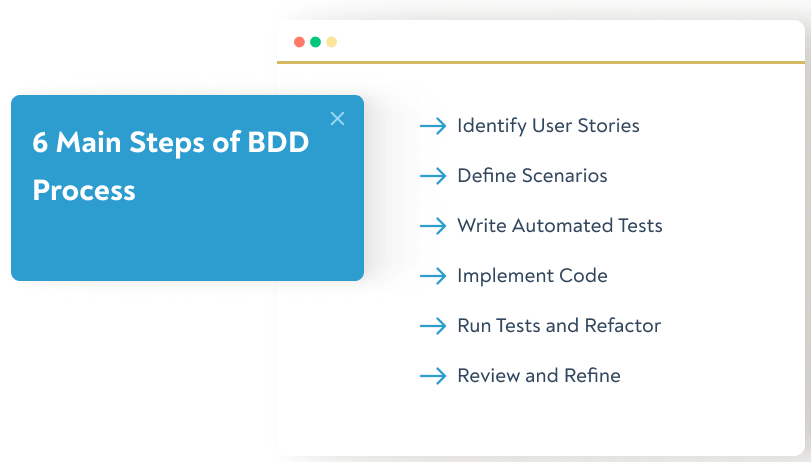What is behaviour-driven development?
Behaviour-driven development (i.e. “specification by example”) is a collaborative approach to defining software’s behaviour using clear, business-focused scenarios. This methodology aims to define software’s behaviour in clear, business-focused scenarios that everyone can understand. The main goal of BDD is to provide a shared understanding between technical and non-technical members of the team. It is a part of Agile methodology in software testing, so without it, you can’t confidently say that “we are agile”. Shortly put, it has 3 main advantages:
- Improved communication
- Better alignment
- Enhanced test coverage.
In, BDD you’ll often come across the Gherkin language, a structured format for writing these scenarios in a way that is understandable by all stakeholders. Gherkin’s syntax is plain English combined with keywords like “Given,” “When,” and “Then,” which makes it accessible and precise for describing software behaviour. This standardisation leads to better communication and collaboration, helping you reach the main goal of BDD we mentioned above: a common understanding between technical and non-technical people.
So, why is behaviour-driven development in agile so crucial? Let’s break it down in the next section.
Why is BDD important?
As mentioned above, one common benefit of applying behavior-driven development in testing is improved communication. According to MoldStud, 90% of the teams that adopted BDD reported better communication among team members. This is the surface-level benefit, whereas the next ones are more specific:
- Better requirements understanding: As BDD envisions clear scenarios beforehand, it also helps your team define clear requirements from the start. It leads to a better understanding of these requirements, which is crucial for the next phases of development.
- Enhanced test coverage: As BDD emphasises creating scenarios that reflect user’s behaviour, it also leads to better test coverage.
- Earlier issue detection: By defining behaviours upfront and involving stakeholders early, BDD helps you identify potential issues sooner. This approach saves time and resources by minimising major problems later in development.
- Living documentation: BDD scenarios and tests serve as living documentation that evolves with your project. This ensures documentation is always up-to-date and accurately reflects the current state of the application.
These advantages of behaviour-driven development sound cool, but what is the real-world application of it? Let’s look at a behaviour-driven development example by providing a scenario.
Behaviour-driven development process
The approach itself consists of several steps. If you want to get the maximum out of its benefits, you should first know the theory. Let’s delve into the steps you have to take:
- Identify User Stories: Collaborate with stakeholders to identify user stories, describing what the user wants to achieve.
- Define Scenarios: For each user story, define clear scenarios using the format Given-When-Then. These scenarios describe the specific behaviours expected from the system. You’ll have an example of how it works below.
- Write Automated Tests: Convert the scenarios into automated tests. These tests will guide the development process and ensure the functionality meets the specified behaviours.
- Implement Code: Developers write the minimal code required to make the tests pass. This ensures the code directly supports the expected behaviours.
- Run Tests and Refactor: Continuously run the automated tests during development. Refactor the code as needed to improve quality while ensuring all tests still pass.
- Review and Refine: Regularly review the scenarios and tests with the entire team. Refine them as necessary to ensure they remain accurate and relevant.

By following these steps, BDD will keep your development process focused on specific behaviour that meets user expectations. Eventually, it leads to better collaboration and understanding among team members.
Example of Behaviour-Driven Development Case Study
Imagine you’re a QA professional in a software development team tasked with creating an online shopping platform. Your team includes developers, testers, and business stakeholders. To ensure everyone is on the same page, you decide to use Behavior-Driven Development.
Scenario: Implementing a Shopping Cart Feature
Your product owner works on a shopping cart feature and discusses the details with the team. You start by discussing the shopping cart feature. The product owner outlines a simple scenario:
“As a customer, I want to add items to my shopping cart, so I can purchase them later.”
Together, you break this down into specific behaviours and agree on a concrete example:
Given the customer has selected an item,
When the customer clicks the “Add to Cart” button,
Then the item should appear in the shopping cart.
With this clear scenario, the developers start writing code to implement the feature. You create automated tests based on the given scenario. These tests ensure the item is added to the cart correctly.
You review the scenario and tests. Running the tests, you verify the behaviour matches the expected outcome. Since the scenario is written in plain language, the business stakeholders easily understand it and confirm it meets their requirements.
Throughout the development process, you continuously refer back to the scenario. It acts as a living document, guiding your work and ensuring everyone is aligned.
As a result, the shopping cart feature is developed efficiently, with fewer misunderstandings and less rework. Your team successfully delivers a functional feature that meets the customer’s needs, all thanks to the clear, collaborative approach of Behavior-Driven Development.
How can a Test Management Solution like aqua cloud help in BDD?
A QA management tool like aqua cloud can significantly streamline and enhance the Behavior-Driven Development (BDD) process. Here’s how its unique features can help:
- AI-Powered Copilot: The AI-powered copilot in aqua cloud assists in writing and refining BDD scenarios, test cases, and test data. It provides intelligent suggestions and improvements, ensuring your scenarios are clear and comprehensive. This feature enhances the collaboration between technical and non-technical team members, making it easier to define and understand behaviours.
- 100% Traceability: aqua cloud offers complete traceability, linking user stories, scenarios, test cases, and defects. This ensures that every behaviour defined in your BDD scenarios is traceable through the entire development lifecycle, from requirements to release. It helps maintain clear visibility and accountability, ensuring that nothing falls through the cracks.
- Automation Integrations: aqua cloud’s robust integration capabilities with various automation tools like Ranorex and Selenium allow you to seamlessly automate your BDD scenarios. Automated tests derived from your Given-When-Then scenarios can be easily managed and executed within aqua, ensuring that your development process is efficient and consistent.
- Bug-Reporting Partner, Capture: aqua cloud’s integration with Capture simplifies bug reporting and management. As you run your BDD scenarios and tests, Capture enables you to quickly document and report any issues. This way, you identify and address defects promptly, maintaining the integrity of your BDD process.
So what are you waiting for? Bringing German quality to the meticulous process like software testing, aqua delivers the ultimate experience. To align your testing efforts with BDD practices, you’ll enjoy aqua’s unique features as we bring you our 20 years of experience in the market. Use full power of AI in your testing efforts, identify and track bugs, and provide your team with a platform that ensures everyone is on the same page.
Use an AI-powered QA management tool to follow BDD practices 100%
Challenges of behaviour-driven development
Although its benefits, a simple Google search will give you social media comments like this about BDD:
I hate BDD. I dunno I feel like I spend more time figuring out what/how to write BDD than actually executing the test itself. Who came up with this?
Apart from this common frustration, BDD also poses challenges like this:
- Time-Consuming Initial Setup: Defining clear scenarios and behaviours requires significant upfront time and collaboration.
- Complexity in Large Projects: Managing and maintaining numerous BDD scenarios can become complex, especially in large projects with many features.
- Difficulty in Writing Good Scenarios: Crafting well-defined, unambiguous scenarios that accurately capture user behaviours can be challenging and require skill.
- Need for Continuous Collaboration: BDD relies heavily on continuous collaboration between developers, testers, and business stakeholders, which can be difficult to sustain.
- The overhead of Maintaining Living Documentation: Keeping the BDD scenarios and associated tests up-to-date as the project evolves requires ongoing effort and can be resource-intensive.
- Resistance to Change: Teams accustomed to traditional development processes may resist adopting BDD practices, leading to friction and slow adoption.
So what conclusion can we derive from this? BDD excels in collaborative environments with complex requirements, while simpler projects with tight deadlines might benefit more from traditional approaches, like TDD.
Rather than making this choice based on assumptions and before we move to the ‘How to implement BDD’, let’s use your actual project data and check if this approach is a good fit for you. The interactive tool below analyzes your team size, complexity, timeline, and collaboration needs to recommend whether BDD or TDD is the better fit. Click to expand it and get your personalized assessment in 2 minutes!
How to implement BDD in your organisation
As mentioned above, there could be different scenarios where you can implement BDD. Let’s look at 2 most common ones:
Scenario 1: Complex Project with Strong Collaboration Needs
In this scenario, your organisation is working on a complex software project with frequent changes in requirements. You have multiple teams—development, testing, and business stakeholders—who need to stay aligned.
Recommendations:
- Start with Training: Provide BDD training for your teams to ensure everyone understands how to write and use BDD scenarios effectively.
- Define Clear User Stories: Work closely with stakeholders to create detailed user stories and scenarios using the Given-When-Then format.
- Integrate Tools: Use BDD-compatible tools to automate tests and manage scenarios efficiently. Tools like aqua cloud can support automation and traceability.
- Prioritise Collaboration: Establish regular meetings to review scenarios and ensure alignment among all teams.
Scenario 2: Simple Project with Tight Deadlines
In this scenario, your organization is developing a straightforward application with a tight deadline and a small team. There’s minimal collaboration required between different roles.
Recommendations:
- Evaluate Needs: Consider whether the benefits of BDD justify the initial setup time and complexity for a simple project. Traditional testing methods may suffice.
- Use Incremental Approach: If BDD is desired, start with a small, manageable subset of the project to pilot its use. This helps evaluate its effectiveness without committing extensive resources.
- Streamline Processes: Keep BDD scenarios simple and focused. Avoid overcomplicating the process to meet deadlines.
By making your approach fit the complexity and needs of your project, you can effectively implement BDD where it adds the most value and choose alternative methods when appropriate.
Behaviour-Driven Development vs. Test-Driven Development
TDD and BDD are often linked or even mixed, as both aim to improve software quality through testing. For example, TDD can reduce production bug density by 40% to 80%, and as we stated above, BDD also helps identify the bugs faster, and more efficiently. Despite their similarities, there are distinct differences between TDD and BDD:
- Focus:
- TDD: Emphasises writing tests based on code functionality.
- BDD: Focuses on behaviours and user requirements, ensuring alignment with business goals.
- Test Writing:
- TDD: Tests are written before code to validate the implementation of specific functions.
- BDD: Tests are written in a natural language format (Given-When-Then) to describe behaviour and user interactions.
- Collaboration:
- TDD: Primarily involves developers in the testing process.
- BDD: Encourages collaboration among developers, testers, and business stakeholders to ensure that all perspectives are considered.
- Documentation:
- TDD: Test cases are often more technical and less accessible to non-developers.
- BDD: Test scenarios are written in a way that is easily understandable by non-technical stakeholders, providing clearer documentation of requirements.
- Scope:
- TDD: Focuses on the correctness of code at a granular level (unit tests).
- BDD: Looks at the overall behaviour and functionality of the system from a higher level (integration and acceptance tests).
Here is a detailed comparison table of TDD vs BDD you can skim through in a few seconds:
| Aspect | TDD | BDD |
|---|---|---|
| Focus | Code Functionality | User behaviours and requirements |
| Test Writing | Technical, based on specific functions | Natural language, describing behaviours (Given-When-Then) |
| Collaboration | Primarily developers | Developers, testers, and business stakeholders |
| Documentation | Technical, less accessible to non-developers | Clear and understandable for non-technical stakeholders |
| Scope | Granular (unit tests) | Higher level (integration and acceptance tests) |
Best tools for behaviour-driven development
Let’s look at the list of the best behaviour-driven development tools for you:
- aqua cloud: aqua offers comprehensive traceability by tracking relationships between requirements, test cases, and scenarios, ensuring alignment throughout the development process. It helps manage the scope of BDD scenarios by visualising dependencies and hierarchies. The AI-powered copilot assists in generating and updating test cases, significantly reducing the time needed and ensuring comprehensive coverage. Additionally, aqua cloud’s automation-integrated test management features streamline the execution and management of BDD scenarios. Its customisable options for organising and prioritising scenarios allow for efficient execution sequencing and dependency management.
Not only these, aqua also provides you with a lightning-fast test case management feature, generating cases just from a voice or text prompt in a few seconds. Its integration with Capture delivers the most seamless experience in bug-reporting. As a test management solution, aqua delivers a centralised hub that will help you see all your testing efforts for a given period. As BDD is a part of Agile practices, you’ll also be interested in aqua’s Agile management practices, where you can add test cases to the backlog and introduce them to your sprints. Overall, aqua does not only help your testing efforts, but it aims to take the all pain of testing from your hands. Are you ready for this transformation?
Streamline not only BDD, but 200% of your testing efforts
- Cucumber: Cucumber allows you to write BDD scenarios in natural language (Gherkin), making them easy to understand and share among team members. It integrates with various testing frameworks for execution.
- SpecFlow: SpecFlow is a .NET tool that enables writing and executing BDD scenarios in Gherkin syntax, integrating with NUnit and MSTest.
- JBehave: JBehave is a Java BDD framework that uses narrative styles to describe behaviour. It supports writing and executing scenarios and integrates with various testing and development tools.
- Behat: Behat is a PHP BDD framework for writing scenarios in a human-readable format and testing them against applications. It integrates well with other PHP testing tools.
Final Words
So, in this guide, you’ve learned that the BDD enhances collaboration and ensures that software aligns with user expectations by focusing on clear, behaviour-driven scenarios. Tools like aqua cloud make BDD implementation more efficient with features such as comprehensive traceability, AI-powered test case generation, and streamlined test management. While BDD excels in improving communication and coverage, it’s crucial to evaluate if it’s the best fit for your project’s needs, or if a more structured approach like Test-Driven Development (TDD) might be preferable. After all, every software project has its own approach to achieving the desired outcome, so it’s up to you.


















